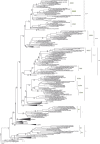Continued evolution of highly pathogenic avian influenza A (H5N1): updated nomenclature
- PMID: 22035148
- PMCID: PMC5074649
- DOI: 10.1111/j.1750-2659.2011.00298.x
Continued evolution of highly pathogenic avian influenza A (H5N1): updated nomenclature
Abstract
Background: Continued evolution of highly pathogenic avian influenza A (H5N1) throughout many regions of the eastern hemisphere has led to the emergence of new phylogenetic groups. A total of 1637 new H5N1 hemagglutinin (HA) sequences have become available since the previous nomenclature recommendations described in 2009 by the WHO/OIE/FAO H5N1 Evolution Working Group. A comprehensive analysis including all the new data is needed to update HA clade nomenclature.
Methods: Phylogenetic trees were constructed from data sets of all available H5N1 HA sequences. New clades were designated on the basis of phylogeny and p-distance using the pre-established nomenclature system (Emerg Infec Dis 2008; 14:e1). Each circulating H5N1 clade was subjected to further phylogenetic analysis and nucleotide sequence divergence calculations.
Results: All recently circulating clades (clade 1 in the Mekong River Delta, 2.1.3 in Indonesia, 2.2 in India/Bangladesh, 2.2.1 in Egypt, 2.3.2, 2.3.4 and 7 in Asia) required assignment of divergent HA genes to new second-, third-, and/or fourth-order clades. At the same time, clades 0, 3, 4, 5, 6, 8, 9, and several second- and third-order groups from clade 2 have not been detected since 2008 or earlier.
Conclusions: New designations are recommended for 12 HA clades, named according to previously defined criteria. In addition, viruses from 13 clades have not been detected since 2008 or earlier. The periodic updating of this dynamic classification system allows continued use of a unified nomenclature in all H5N1 studies.
© 2011 Blackwell Publishing Ltd.
Figures

References
-
- World Health Organization/World Organisation for Animal Health/Food and Agriculture Organization H5N1 Evolution Working Group . Towards a unified nomenclature system for highly pathogenic avian influenza virus (H5N1). Emerg Infec Dis 2008; 14:e1. doi: 10.3201/eid1407.071681. - DOI - PMC - PubMed
-
- Swofford DL. PAUP*: Phylogenetic Analysis Using Parsimony (and Other Methods) 4.0 Beta. Sunderland, MA: Sinauer Associates, 2001.
-
- Tamura K, Dudley J, Nei M, Kumar S. MEGA4: molecular evolutionary genetics analysis (MEGA) software version 4.0. Mol Biol Evol 2007; 24:1596–1599. - PubMed
MeSH terms
Substances
LinkOut - more resources
Full Text Sources
Other Literature Sources
Medical

